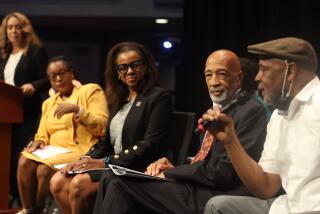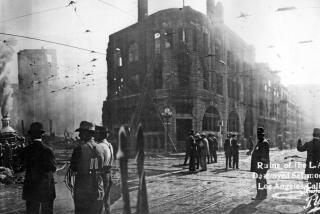Times Coverage of LAPD, Minority Areas
- Share via
Thirteen years ago, when editors at the Los Angeles Times took more than three months to realize that the police shooting of a black woman named Eulia Love should be a Page 1 story, Esquire magazine said The Times “probably didn’t give a damn . . . about Eulia Love and assumed its readers didn’t either.”
It was not the first--or the last--such criticism of The Times.
The Times is the city’s longtime Establishment newspaper, its dominant, agenda-setting newspaper, and--like most big-city media--it has long been accused of not being interested in what happens in black communities, where the paper has traditionally had few readers or advertisers.
The Times has “lots of people who do care” (about blacks), says Jay Mathews, who covered Los Angeles for the Washington Post from 1981 to 1991 and is married to a former Times editor and reporter, but ultimately “what happens in certain parts of the city has never been that important.”
In Mathews’ view, this attitude “reflects the background of the editors and their readership.”
Like everyone else interviewed for this story, Mathews spoke before the riots, and Times editors denied his charges then and now. They say no other mainstream news organization in Los Angeles has done as much as The Times over the years to report and analyze the plight of minorities.
The Times has no bureau or regional section in either South-Central Los Angeles or East Los Angeles. Editor Shelby Coffey says plans are being finalized for a new section covering community news in the central city areas.
The paper also has relatively few black or Latino reporters. As Metropolitan Editor Craig Turner notes: “I think it is a handicap if you don’t have reporters who are plugged into the black community, and that has been . . . a problem that we’ve had at The Times.”
Although The Times has hired more black reporters in recent years in an effort to alleviate that problem--and many of them were pressed into service during the riots--major decisions in the media are made by editors, not reporters. The third-ranking editor on The Times editorial pages is a black woman, but The Times has no blacks in top-level, decision-making positions with responsibility for coverage of the daily news. The paper’s editor, managing editor, senior editor, national editor, foreign editor, metropolitan editor, city editor and business editor are all white males.
Some major newspapers--the New York Times, Washington Post, Miami Herald, Detroit Free Press--have high-ranking black editors, but the situation at the L. A. Times is typical of most mainstream media. No commercial TV station in Los Angeles has a black or Latino news director.
Minorities say this helps explain why the media often cover minority issues inadequately--especially an issue such as police misconduct in minority communities. Editors and news directors who have not lived in such communities often find reports of routine police harassment and excessive force in those areas hard to believe.
Thus, the mainstream media in Los Angeles provided no thorough examination of that issue in the late 1980s, despite evidence that such behavior was increasing. Even when the media covered instances of police misconduct in minority communities, coverage was often either late or underplayed.
In August 1988, when 88 LAPD officers trashed two apartment buildings on Dalton Avenue and 39th Street in South-Central, KNXT (now KCBS) Channel 2 broadcast a story on the raid the night after it happened. But The Times did not publish its first story until four days after the raid. No Times editor who was asked about Dalton Avenue could recall why the paper didn’t react more quickly, but that the first story and the next one--eight days later--were relatively short and written by a summer intern, not a regular reporter.
Although both stories were published on the front page of the Metro section and The Times later published several, longer stories on Dalton, the paper did not put Dalton Avenue on Page 1 of the main edition until five months after the raid.
All that would seem to suggest that, as with Eulia Love, The Times was slow to recognize the significance of Dalton Avenue--a case that would become a cause celebre in the black community and lead to city payments of more than $3.8 million to victims of the raid.
Andrea Ford, a black reporter at The Times, says her teen-age sons were frequently harassed by police, and that when she was assigned to cover the LAPD in 1989 she began hearing frequent and consistent allegations of similar police misconduct throughout South-Central.
Ford says she was not surprised that her white editors “did not take police brutality in the black community seriously; they have no experience like that.” But she says she was surprised--and angry--that her editors did not seem interested in having the paper thoroughly examine the issue after she and other blacks told them about it.
Peter H. King, then city editor of The Times and now a columnist, says he did take the issue seriously, and in early 1990, he asked reporter Ron Harris to look at police treatment of young black males.
Harris made preliminary inquiries and wrote King a lengthy memo proposing a broad series of perhaps 10 stories probing police treatment of blacks. Much of what Harris wrote in his memo foreshadowed what would later be written in The Times and other media in the aftermath of the Rodney G. King beating, but King said he “wasn’t interested in a story that laid out a lot of facts.” He wanted a more personal, “subjective . . . impressionistic” story, rather than the traditional reportage Harris favored.
Harris says he knew King’s approach would yield stories that “would pull at the heartstrings of the readers,” but he thought that approach too “touchy-feely” to be effective on this issue.
Harris declined to do the story King’s way; King thought that his way was the right way--and that Harris, a talented black reporter, was the only person on the staff who could do it right.
So no one did it--until about five months after the King beating, when Peter King asked Stephen Braun, a talented white reporter, to look at police-minority relations. Braun’s moving, six-part series, “Scenes From the Inner City,” was published four months later.
More to Read
Sign up for Essential California
The most important California stories and recommendations in your inbox every morning.
You may occasionally receive promotional content from the Los Angeles Times.










